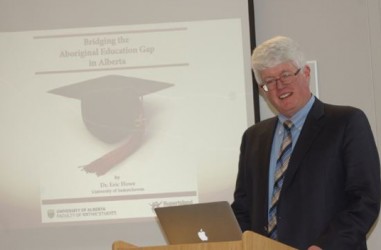Article Origin
Volume
Issue
Year
Audrey Poitras is hopeful that a study recently released by the Rupertland Métis Centre for Research will impress upon the provincial government that investing in education for Métis people is critical.
“The Howe report… sends out a clear call for both community and government action,” said Poitras, president of the Métis Nation of Alberta.
The report, entitled Bridging the Aboriginal Education Gap in Alberta, was released in early March. It was a collaborative effort undertaken by RMCR, the University of Alberta and the MNA.
The study uses forensic economics to “assign a dollar value to lifetime earnings depending on education,” said author and University of Saskatchewan professor Dr. Eric Howe, who has done similar analyses in Saskatchewan and Ontario.
“What the analysis concludes is that Alberta is leaving over a quarter of a trillion dollars unrealized and unclaimed, money that is essentially just lying on the ground, waiting to be picked up through Aboriginal education programs,” said Howe.
There is a growing education gap between Aboriginals and non-Aboriginals. In Alberta, that gap is rising rapidly because of the increased Aboriginal population coming in to the province and, though more Aboriginal people are improving their education, non-Aboriginal people are attaining higher education at an even greater rate.
According to the report, over half of the non-Aboriginal population in Alberta has post-secondary credentials compared to the Métis population where over half has a high school diploma or less, and First Nations, where less than half has high school or less. Bridging that gap with education would result in $44.2 billion of increased earnings for Aboriginal people.
Howe points out that increased education results in a “myriad of benefits” beyond improved wages. Those benefits include longer, healthier life spans, longer paid vacations, lower rates of crime and improved child care.
Taking wage factors and nonmonetary advantages into consideration, the benefit of bridging the Aboriginal education gap is $270.5 billion, according to the report. In Ontario, which has an economy on par with Alberta, the aggregate figure for the benefits of bridging the education gap was $220 billion, while Saskatchewan, with a much smaller economy, had an aggregate figure of $90 billion.
The Alberta report breaks down earnings based on level of education attained for non-Aboriginal, Métis, and First Nations, as well as for men and women.
This report is one of many that the RCMR and the university will undertake, says Dr. Brendan Hokowhitu, Dean of Native Studies Faculty with U of A.
“The results are critical,” said Hokowhitu, “and demonstrate the importance of Indigenous groups, and particularly Métis to the growth of Alberta and Canada economically.”
The report will be delivered to policy makers and RCMR is willing to have a discussion with the government, says RCMR director Dr. Chris Anderson.
“We have actually received zero dollars (from the provincial government) to the Métis Nation for education for K-12. Of course we’re hoping things like this report will be able to help us to do whatever we need to do to change that. Hopefully somewhere down the road there will be a change in the view on supporting the Métis Nation to support Métis students,” said Poitras.
- 1874 views

